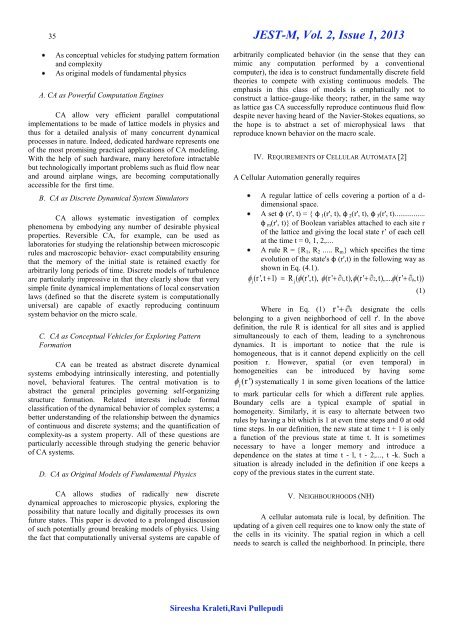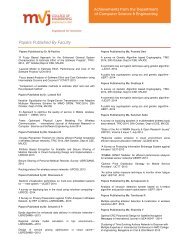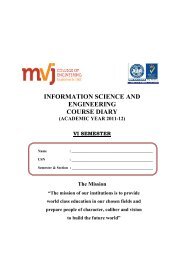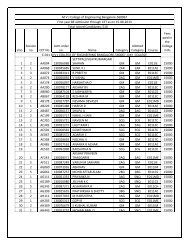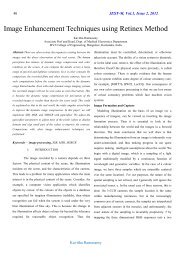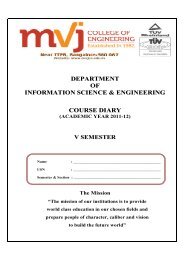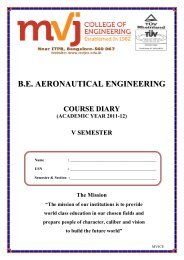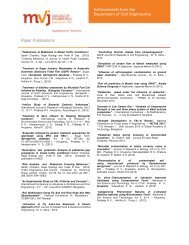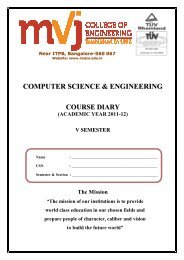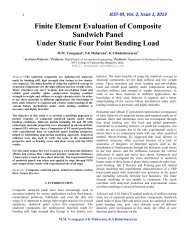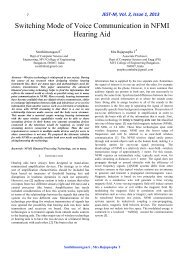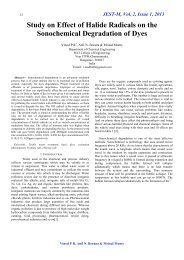JEST-M, Vol. 2, Issue 1, 2013 - MVJ College of Engineering
JEST-M, Vol. 2, Issue 1, 2013 - MVJ College of Engineering
JEST-M, Vol. 2, Issue 1, 2013 - MVJ College of Engineering
You also want an ePaper? Increase the reach of your titles
YUMPU automatically turns print PDFs into web optimized ePapers that Google loves.
35 <strong>JEST</strong>-M, <strong>Vol</strong>. 2, <strong>Issue</strong> 1, <strong>2013</strong><br />
As conceptual vehicles for studying pattern formation<br />
and complexity<br />
As original models <strong>of</strong> fundamental physics<br />
A. CA as Powerful Computation Engines<br />
СA allow very efficient parallel computational<br />
implementations to be made <strong>of</strong> lattice models in physics and<br />
thus for a detailed analysis <strong>of</strong> many concurrent dynamical<br />
processes in nature. Indeed, dedicated hardware represents one<br />
<strong>of</strong> the most promising practical applications <strong>of</strong> CA modeling.<br />
With the help <strong>of</strong> such hardware, many heret<strong>of</strong>ore intractable<br />
but technologically important problems such as fluid flow near<br />
and around airplane wings, are becoming computationally<br />
accessible for the first time.<br />
B. CA as Discrete Dynamical System Simulators<br />
CA allows systematic investigation <strong>of</strong> complex<br />
phenomena by embodying any number <strong>of</strong> desirable physical<br />
properties. Reversible CA, for example, can be used as<br />
laboratories for studying the relationship between microscopic<br />
rules and macroscopic behavior- exact computability ensuring<br />
that the memory <strong>of</strong> the initial state is retained exactly for<br />
arbitrarily long periods <strong>of</strong> time. Discrete models <strong>of</strong> turbulence<br />
are particularly impressive in that they clearly show that very<br />
simple finite dynamical implementations <strong>of</strong> local conservation<br />
laws (defined so that the discrete system is computationally<br />
universal) are capable <strong>of</strong> exactly reproducing continuum<br />
system behavior on the micro scale.<br />
C. CA as Conceptual Vehicles for Exploring Pattern<br />
Formation<br />
CA can be treated as abstract discrete dynamical<br />
systems embodying intrinsically interesting, and potentially<br />
novel, behavioral features. The central motivation is to<br />
abstract the general principles governing self-organizing<br />
structure formation. Related interests include formal<br />
classification <strong>of</strong> the dynamical behavior <strong>of</strong> complex systems; a<br />
better understanding <strong>of</strong> the relationship between the dynamics<br />
<strong>of</strong> continuous and discrete systems; and the quantification <strong>of</strong><br />
complexity-as a system property. All <strong>of</strong> these questions are<br />
particularly accessible through studying the generic behavior<br />
<strong>of</strong> СA systems.<br />
D. CA as Original Models <strong>of</strong> Fundamental Physics<br />
CA allows studies <strong>of</strong> radically new discrete<br />
dynamical approaches to microscopic physics, exploring the<br />
possibility that nature locally and digitally processes its own<br />
future states. This paper is devoted to a prolonged discussion<br />
<strong>of</strong> such potentially ground breaking models <strong>of</strong> physics. Using<br />
the fact that computationally universal systems are capable <strong>of</strong><br />
arbitrarily complicated behavior (in the sense that they can<br />
mimic any computation performed by a conventional<br />
computer), the idea is to construct fundamentally discrete field<br />
theories to compete with existing continuous models. The<br />
emphasis in this class <strong>of</strong> models is emphatically not to<br />
construct a lattice-gauge-like theory; rather, in the same way<br />
as lattice gas CA successfully reproduce continuous fluid flow<br />
despite never having heard <strong>of</strong> the Navier-Stokes equations, so<br />
the hope is to abstract a set <strong>of</strong> microphysical laws that<br />
reproduce known behavior on the macro scale.<br />
IV. REQUIREMENTS OF CELLULAR AUTOMATA [2]<br />
A Cellular Automation generally requires<br />
A regular lattice <strong>of</strong> cells covering a portion <strong>of</strong> a d-<br />
dimensional space.<br />
A set ф (r', t) = { ф 1(r', t), ф 2(r', t), ф 3(r', t)................<br />
ф m(r', t)} <strong>of</strong> Boolean variables attached to each site r<br />
<strong>of</strong> the lattice and giving the local state r’ <strong>of</strong> each cell<br />
at the time t = 0, 1, 2,....<br />
A rule R = {R 1 , R 2 ..... R m } which specifies the time<br />
evolution <strong>of</strong> the state's ф (r',t) in the following way as<br />
shown in Eq. (4.1).<br />
(r ', t 1) R ( (r ', t), (r ' 1, t), (r ' 2, t),.... (r ' q, t))<br />
j<br />
j<br />
Where in Eq. (1) r' k designate the cells<br />
belonging to a given neighborhood <strong>of</strong> cell r'. In the above<br />
definition, the rule R is identical for all sites and is applied<br />
simultaneously to each <strong>of</strong> them, leading to a synchronous<br />
dynamics. It is important to notice that the rule is<br />
homogeneous, that is it cannot depend explicitly on the cell<br />
position r. However, spatial (or even temporal) in<br />
homogeneities can be introduced by having some<br />
(r ') systematically 1 in some given locations <strong>of</strong> the lattice<br />
j<br />
to mark particular cells for which a different rule applies.<br />
Boundary cells are a typical example <strong>of</strong> spatial in<br />
homogeneity. Similarly, it is easy to alternate between two<br />
rules by having a bit which is 1 at even time steps and 0 at odd<br />
time steps. In our definition, the new state at time t + 1 is only<br />
a function <strong>of</strong> the previous state at time t. It is sometimes<br />
necessary to have a longer memory and introduce a<br />
dependence on the states at time t - l, t - 2,..., t -k. Such a<br />
situation is already included in the definition if one keeps a<br />
copy <strong>of</strong> the previous states in the current state.<br />
V. NEIGHBOURHOODS (NH)<br />
A cellular automata rule is local, by definition. The<br />
updating <strong>of</strong> a given cell requires one to know only the state <strong>of</strong><br />
the cells in its vicinity. The spatial region in which a cell<br />
needs to search is called the neighborhood. In principle, there<br />
(1)<br />
Sireesha Kraleti,Ravi Pullepudi


